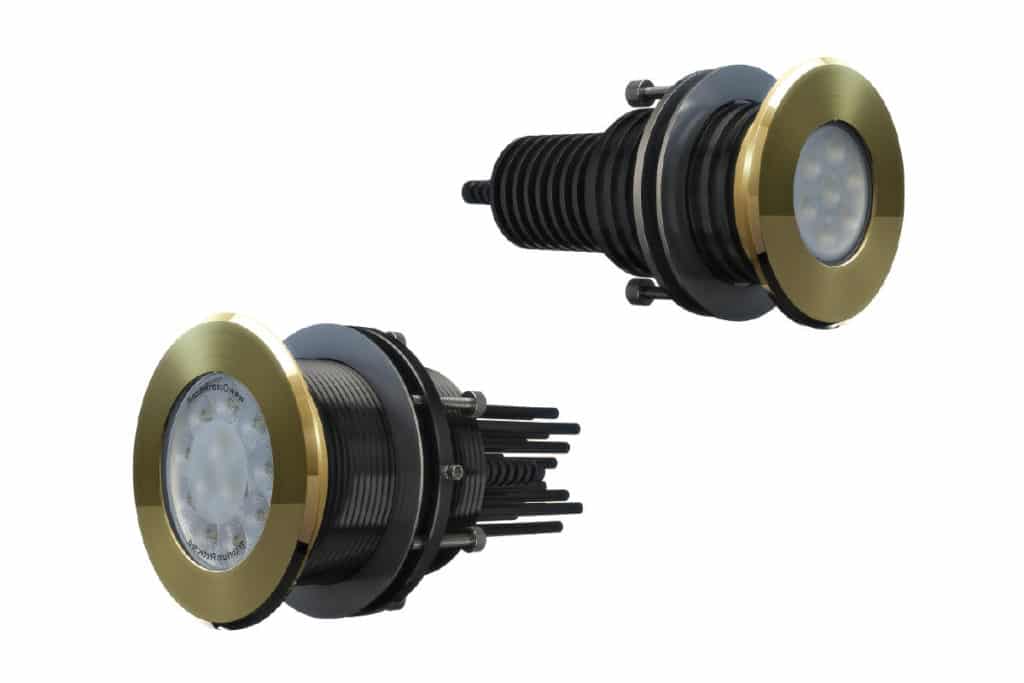
Incandescent Versus LED
With regular incandescent bulbs, we used wattage to determine the brightness, along with soft- or bright-light designators. An incandescent bulb of 100 watts or 60 watts uses identical filaments heated to the same temperature. To increase light output, you have to increase wattage, which is why they generate heat and are considered energy wasters. With incandescent bulbs, light is emitted equally all around the bulb, which also results in lost light.
With LED lighting, the fixture forms an integrated system with integral LED lights, fixture housing and optics, which makes them deliver almost all of their light in a focused direction. An LED’s beam of light produces no infrared energy, giving the illusion that it produces no heat. LEDs do generate heat during the conversion of electricity to light, so manufacturers usually use heat sinks to pull heat away from the LED and disperse it into the air surrounding the fixture, making them burn cooler.

Aqualuma has been producing underwater lighting since 2005 on Australia’s Gold Coast, with a distribution facility in South Florida. The company utilizes a patented injection-molded, virtually indestructible polymer housing that is tested to 1,300 feet below sea level. The new Gen4 18 Series features the same housing the 12 and 6 Series use, so upgrading becomes seamless. The largest through-hull option offered by Aqualuma, the 18 Series, can be serviced from within the boat. The 18 Series comes in brilliant white with 4,920 low-light fixture lumens and ultra blue with 14,100 low-light fixture lumens. There is a three-year warranty on the internal components and a six-year warranty on the housing. The lights come in 12 volt with a 2.6-amp draw or 24 volt with a 1.3-amp draw, along with 12 feet of number 2 conductor wire.

U.K.-based OceanLED started in 2005 with underwater LED lights, and it also has a distribution facility in South Florida. With a low-profile aluminum bronze bezel and hard-anodized aluminum body with a Tritonium-coated lens, the company’s all-new 50XFM and 150XFM Pro Series HD Allure lights can be serviced from within the boat. They feature ultra white and midnight blue LEDs with a 60-degree beam angle.
With increased lumen output, over 40,000 LED life hours and 6,500 fixture lumens, the lights feature AC and DC power options, including 110-volt 600mA draw and 240-volt 275mA draw. The AC driver comes with a power cable. The 12-volt version has a 5.5‑amp draw and the 24-volt model draws 2.75 amps. The DC driver also comes with a power cable, with waterproof Deutsche plug-and-play quick connects and reverse-polarity protection.

Lumishore, another U.K.-based company, focuses only on underwater lighting, with U.S. offices on Florida’s west coast. The company’s TIX 202 Interchangeable Thru Hull comes in white, blue and green. Lumishore has engineered the light in a high-conductivity marine-grade aluminum bronze with a borosilicate lens that can be fully serviced or interchanged from within the hull.
Featuring a two-year warranty, the lights have 4,100 fixture lumens, a 60-degree beam angle and an estimated 50,000-hour life. The 12-volt version draws 3.6 amps and the 24-volt model draws 1.8 amps. There is also an optional AC power supply. The TIX 202 comes with overvoltage, reverse-polarity and thermal rollback protections.

Bluefin LED is a new kid on the block that also hails from the U.K. The company introduced a complete range of red, green, blue and white colorchanging underwater lights in 2014, along with the first colorchanging RGBW underwater dock light. The new Barracuda B12 light comes in an aluminum bronze marine-grade housing with 4,500 fixture lumens, and it can be mounted on the transom or hull side. Featuring over 50,000 hours of LED life, the 12-volt model draws 4.6 amps and the 24-volt draws 2.35 amps. The B12 has overvoltage and under-voltage protection, with reverse-polarity and active thermal protection as well. It also features a high-impact polymer lens with a 60-degree beam angle, and it comes with a two-year warranty.
The popularity of underwater lights has increased tremendously, and walking down any dock, or in an anchorage at night, you will surely see some boats lit up. With a wide selection and improved technologies, a solution that fits your needs and performs to your expectations will be easy to find. So when you are ready to light it up, several great options exist for your particular application.







